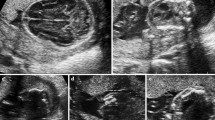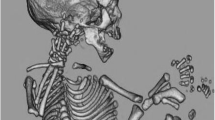Abstract
Objective
The purpose of the paper was to assess the morphometric parameters to improve the specificity of the ultrasound (US) signs for the early differential diagnosis between two lethal dysplasias, as thanatophoric dysplasia (TD) and osteogenesis imperfecta type 2 (OI-2).
Method
The diaphyseal length and the bowed shape of long bones associated with vertebral body dimension assessment were investigated in a group of 14 pregnancy terminations carried out in the time period 2007–2013. The definitive diagnosis was established after pregnancy termination by means of skeletal standardized X-rays, histopathology and gene analysis.
Results
TD and OI-2 long bones were significantly shorter than controls. No significant differences were observed between the two dysplasias. The bowing angle was higher in OI-2; a true angulation or eventually axial displacement was present only in the latter. Furthermore, they did not show any evidence of vertebral collapse. The thanatophoric dysplasia presented less bowed long bones, and never true angulation. The spine was steadily characterized by flattened anterior vertebral bodies.
Conclusion
Long bone shortening is not a sufficient and accurate sign for early sonographic differential diagnosis between TD and OI-2. Angled diaphysis, axial diaphyseal displacement and a conserved vertebral body height in the prenatal period support the diagnosis of osteogenesis imperfecta type 2, while moderately regular bowed diaphysis associated with platyspondyly that of thanatophoric dysplasia.







Similar content being viewed by others

References
Alanay Y, Krakow D, Rimoin DL et al (2007) Angulated femurs and the skeletal dysplasia: experience of the international skeletal dysplasia registry (1988–2006). Am J Genet A 143:1159–1168
Schild RL, Hunt GH, Moore J et al (1996) Antenatal sonographic diagnosis of thanatophoric dysplasia: a report of three cases and a review of the literature with special emphasis on the differential diagnosis. Ultrasound Obstet Gynecol 8:62–67
Wilcox WR, Tavormina PL, Krakow D et al (1998) Molecular, radiologic, and histopathologic correlations in thanatophoric dysplasia. Am J Med Genet 78:274–281
Tonni G, Azzoni D, Ventura A et al (2010) Thanatophoric dysplasia type I associated with increased nuchal translucency in the first trimester: early prenatal diagnosis using combined ultrasonography and molecular biology. Fetal Pediatr Pathol 29:314–322
Chitty LS, Khalil A, Barrett AN et al (2013) Safe, accurate, prenatal diagnosis of thanatophoric dysplasia using ultrasound and free fetal DNA. Prenat Diagn 33:416–423
Teele RL (2006) A guide to the recognition of skeletal disorders in the fetus. Pediatr Radiol 36:473–484
Khalil A, Pajkrt E, Chitty LS (2011) Early prenatal diagnosis of skeletal anomalies. Prenat Diagn 31:115–124
Giancotti A, Castori M, Spagnuolo A et al (2011) Early ultrasound suspect of thanatophoric dysplasia followed by first trimester molecular diagnosis. Am J Med Genet A 155:1756–1758
Iwata T, Chen L, Li C et al (2000) A neonatal lethal mutation in FGFR3 uncouples proliferation and differentiation of growth plate chondrocytes in embryos. Hum Mol Genet 9:1603–1613
Lievens PM, Liboi E (2003) The thanatophoric dysplasia type II mutation hampers complete maturation of fibroblast growth factor receptor 3 (FGFR3), which activates signal transducer and activator of transcription 1 (STAT1) from the endoplasmic reticulum. J Biol Chem 278:17344–17349
Martínez-Frías ML, de Frutos CA, Bermejo E et al (2010) ECEMC Working Group. Review of the recently defined molecular mechanisms underlying thanatophoric dysplasia and their potential therapeutic implications for achondroplasia. Am J Med Genet A 152:245–255
Forlino A, Cabral WA, Barnes AM et al (2011) New perspectives on osteogenesis imperfecta. Nat Rev Endocrinol 7:540–557
Van Dijk FS, Nesbitt IM, Nikkels PG et al (2009) CRTAP mutations in lethal and severe osteogenesis imperfecta: the importance of combining biochemical and molecular genetic analysis. Eur J Hum Genet 17:1560–1569
Bellus GA, Spector EB, Speiser PW et al (2000) Distinct missense mutations of the FGFR3 lys650 codon modulate receptor kinase activation and the severity of the skeletal dysplasia phenotype. Am J Hum Genet 67:1411–1421
Dighe M, Fligner C, Cheng E et al (2008) Fetal skeletal dysplasia: an approach to diagnosis with illustrative cases. Radiographics 28:1061–1077
Renna MD, Pisani P, Conversano F et al (2013) Sonographic markers for early diagnosis of fetal malformations. World J Radiol 5:356–371
Cassart M (2010) Suspected fetal skeletal malformations or bone diseases: how to explore. Pediatr Radiol 40:1046–1051
Parilla BV, Leeth EA, Kambich MP et al (2003) Antenatal detection of skeletal dysplasias. J Ultrasound Med 22:255–258
Pazzaglia UE, Donzelli CM, Izzi C et al (2014) Thanatophoric dysplasia. Correlation among bone X-ray morphometry, histopathology, and gene analysis. Skeletal Radiol 43:1205–1215
Tsai PY, Chang CH, Yu CH et al (2012) Three-dimensional ultrasound in the prenatal diagnosis of osteogenesis imperfecta. Taiwan J Obstet Gynecol 51:387–392
Rouse GA, Filly RA, Toomey F et al (1990) Short-limb skeletal dysplasias: evaluation of the fetal spine with sonography and radiography. Radiology 174:177–180
Author information
Authors and Affiliations
Corresponding author
Ethics declarations
Conflict of interest
The authors declare no conflicts of interest.
Ethical approval
All procedures performed in studies involving human participants were in accordance with the ethical standards of the institutional and/or national research committee and with the 1964 Helsinki declaration and its later amendments or comparable ethical standards.
Funding
No funding was received for this research.
Rights and permissions
About this article
Cite this article
Bondioni, M.P., Pazzaglia, U.E., Izzi, C. et al. Comparative X-ray morphometry of prenatal osteogenesis imperfecta type 2 and thanatophoric dysplasia: a contribution to prenatal differential diagnosis. Radiol med 122, 880–891 (2017). https://doi.org/10.1007/s11547-017-0784-0
Received:
Accepted:
Published:
Issue Date:
DOI: https://doi.org/10.1007/s11547-017-0784-0



